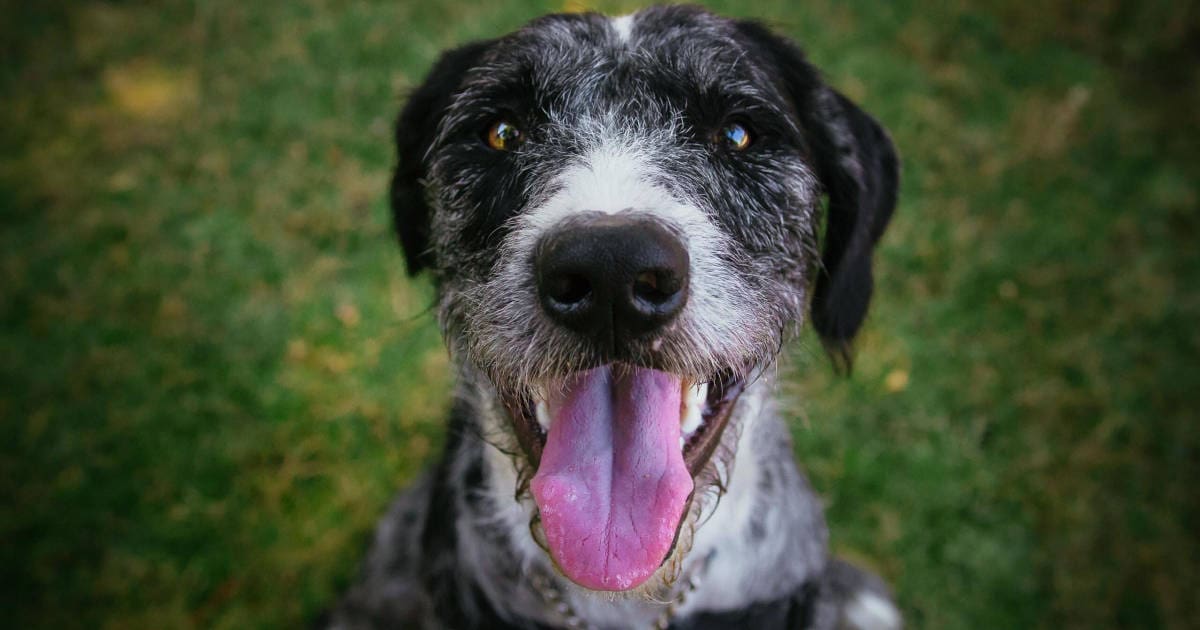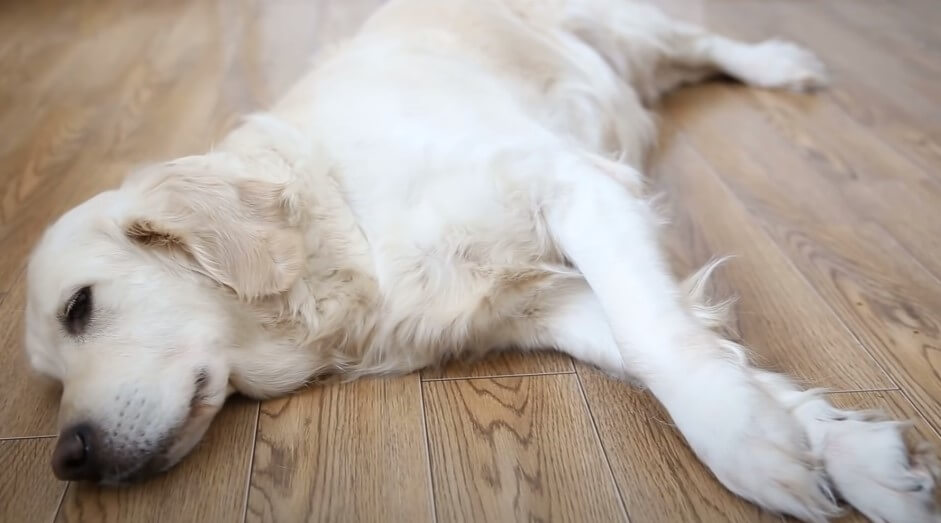Dogs move from spot to spot while sleeping to regulate their body temperature and find a comfortable position. This behavior is instinctual and helps them avoid discomfort or overheating.
Have you ever wondered why your furry friend constantly shifts positions while snoozing? It turns out that dogs have a good reason for their restless behavior. While you may think they’re simply repositioning for comfort, there’s actually more to it.
Dogs move from spot to spot during sleep to regulate their body temperature and find the most comfortable position possible. This instinctual behavior helps them avoid discomfort or overheating, ensuring a more restful slumber.
In this article, we will explore this fascinating aspect of canine behavior, why does my dog move from spot to spot while sleeping? and we will discuss shedding light on the reasons behind their constant movement while sleeping. So, if you’re curious about your dog’s restless sleep habits, keep reading to uncover the secrets behind their seemingly never-ending search for the perfect spot.
Why Does My Dog Move From Spot To Spot While Sleeping
Dogs often move from spot to spot while sleeping due to their instinctual behaviors inherited from their wild ancestors. In the wild, constant movement during sleep helped protect them from potential dangers and kept them alert to their surroundings.
This trait has persisted in domesticated dogs. Additionally, dogs may shift positions to find a more comfortable or cooler spot, as they regulate their body temperature differently than humans.
Dreaming could also prompt these movements as they act out their dreams. Overall, these habits are entirely normal and reflect the instinctual and adaptive nature of dogs during rest, ensuring their safety and well-being.

Credit: toegrips.com
Understanding Canine Sleep Behavior
Have you ever wondered why your dog moves from spot to spot while sleeping? It may seem odd, but it’s actually quite common behavior in our furry friends. Understanding why dogs do this can provide insights into their sleep patterns and behavior.
we will delve into the topic of canine sleep behavior, exploring the different sleep stages in dogs and the significance of rapid eye movement (rem) sleep and non-rapid eye movement (NREM) sleep.
Different Sleep Stages In Dogs
Dogs, like humans, experience different sleep stages. These stages can vary in duration and intensity, and they play a crucial role in helping dogs maintain optimal physical and mental health. The sleep stages in dogs can be categorized into two main types: rapid eye movement (rem) sleep and non-rapid eye movement (NREM) sleep.
Let’s take a closer look at each stage and its significance.
Rapid Eye Movement (Rem) Sleep And Its Significance
Rem sleep is often referred to as the “dreaming stage” of sleep. During this phase, dogs may exhibit various behaviors like twitching, whimpering, or paddling their paws. This is because rem sleep is associated with increased brain activity, similar to when humans dream.
It is believed that rem sleep is vital for memory consolidation and emotional processing in dogs. It also plays a role in the growth and development of puppies.
Some key points about rem sleep in dogs include:
- Rem sleep is characterized by rapid eye movements, hence the name.
- Most dreaming occurs during rem sleep, and dogs may exhibit physical movements as if they are acting out their dreams.
- The brain is highly active during rem sleep, which is thought to be linked to cognitive processes in dogs.
Non-Rapid Eye Movement (Nrem) Sleep And Its Role
NREM sleep is the other sleep stage that dogs experience. Unlike rem sleep, NREM sleep is a deeper and more restful stage of sleep. It is essential for bodily restoration and ensures that dogs wake up feeling refreshed. This stage can be further divided into three phases: n1, n2, and n3.
N1 is the lightest phase, while n3 is the deepest.
Here are some key points about NREM sleep in dogs:
- NREM sleep is crucial for the body to repair and regenerate tissues, strengthen the immune system, and support overall health.
- It is in the n3 phase that dogs experience the deepest sleep, with reduced muscle activity and a lower responsiveness to external stimuli.
- During NREM sleep, dogs may show minimal movements or lie still as they enter a state of deep relaxation.
Understanding the different sleep stages in dogs, including rem sleep and NREM sleep, can shed light on the reasons why your four-legged companion moves from spot to spot while sleeping. These behaviors are likely indicative of the transitions between sleep stages as their bodies adjust and find comfort.
Next time you observe your dog shifting positions during slumber, you’ll have a better understanding of their sleep behavior and the incredible world of canine sleep.
Uncovering The Reasons For Restless Shifting
Dogs can be quite the mystery when it comes to their sleeping habits. Have you ever wondered why your furry friend moves from spot to spot while snoozing? It turns out there are several reasons behind this restless shifting.

In this blog post, we will uncover the factors that contribute to this behavior, including discomfort and physical disturbances during sleep, health conditions affecting canine sleep patterns, and behavioral factors influencing restlessness.
Discomfort And Physical Disturbances During Sleep
- Dogs may experience discomfort due to their sleeping surface, such as an uneven or uncomfortable bed.
- External factors like noise or temperature fluctuations can disrupt their sleep, causing them to move around to find a more comfortable spot.
- Dreaming can lead to sudden movements, as dogs try to act out the movements from their dreams.
Health Conditions Affecting Canine Sleep Patterns
- Dogs with arthritis or joint pain may shift positions frequently to alleviate discomfort.
- Medical conditions like urinary tract infections or gastrointestinal issues can cause restlessness during sleep.
- Certain medications may interfere with a dog’s sleep, leading to increased movement.
Behavioral Factors Influencing Restlessness
- Dogs are instinctively alert animals, and even when sleeping, they remain vigilant to their surroundings. They may change positions to ensure they are aware of any potential threats.
- Separation anxiety or stress can result in a dog moving from spot to spot while sleeping.
- Some dogs have a natural tendency to be more active during sleep, leading to increased movement.
By understanding the reasons behind your dog’s restless shifting during sleep, you can better address their needs and provide a more comfortable environment. While occasional movement during sleep is normal, excessive restlessness or abnormal behavior may warrant a visit to the veterinarian.
Paying attention to your dog’s sleep patterns can help ensure they get the rest they need for optimal health and well-being. So, the next time you see your furry friend shuffling around in their sleep, you’ll have a deeper understanding of why they do it.
Identifying Common Sleep Disruptors
Dogs are fascinating creatures, especially when it comes to their sleeping habits. Have you ever wondered why your furry friend moves from spot to spot while snoozing? It turns out that there are several common sleep disruptors that can cause this behavior.
Let’s take a closer look at some of these factors and how they impact your dog’s sleep quality.
Environmental Factors Impacting Sleep Quality
- Noise disturbances: Loud sounds, such as traffic, construction, or even barking from other pets, can disrupt your furry companion’s peaceful slumber. A noisy environment can lead to frequent movements as your dog seeks a quieter spot.
- Temperature changes: Dogs are sensitive to temperature, just like humans. If they feel too hot or too cold, they may change their sleeping position in search of a more comfortable spot. Keep an eye on the ambient temperature and provide adequate bedding to help your dog maintain optimal sleep conditions.
- Light disturbances: Dogs are generally sensitive to light, especially during nighttime sleep. Bright lights or a poorly lit room can be disruptive, prompting your dog to relocate to a darker area where they can sleep without any distractions.
Separation Anxiety And Its Effect On Canine Sleep
- Separation anxiety: Dogs are pack animals and thrive on social interaction. When left alone for extended periods, they can experience anxiety, which can interfere with their sleep. The restlessness and movement while sleeping could be a manifestation of this anxiety.
- Seeking comfort: Dogs may change their sleeping spots in search of a more secure or comforting area. This could be a result of feeling unsafe or insecure in their current location. By moving around, they are trying to find a spot where they feel more at ease and can relax.
Understanding these common sleep disruptors can help you better analyze your dog’s sleeping habits. By minimizing noise, ensuring a comfortable temperature and lighting environment, and addressing any separation anxiety issues, you can help your furry friend enjoy a more restful and uninterrupted sleep.
So, the next time you notice your dog moving from spot to spot while sleeping, consider these factors and make the necessary adjustments to create a peaceful sleeping environment for your beloved pet.
Exploring Health Issues And Restless Sleep
If you’ve ever watched your dog sleep, you may have noticed some peculiar behavior. One common observation is their constant movement from spot to spot. But have you ever wondered why they do that? In this blog post, we’ll explore the topic of why dogs move from spot to spot while sleeping.
In particular, we’ll delve into the connection between health issues and restless sleep. So, let’s unravel the mysteries behind your furry friend’s restless sleep patterns.
Arthritis And Joint Pain Disrupting Sleep
- Dogs, just like humans, can suffer from arthritis and joint pain, especially as they age.
- Restless sleep and frequent changes in position can be a way for dogs to find a comfortable spot that alleviates the discomfort caused by arthritis.
- Arthritis can make sleeping on hard surfaces painful, leading dogs to constantly seek out softer and more supportive areas to rest.
Digestive Issues Causing Discomfort During Sleep
- Digestive problems such as indigestion, acid reflux, or even food allergies can cause discomfort in dogs while they sleep.
- Dogs instinctively change positions to find relief from this discomfort, which could result in them moving from spot to spot.
- Certain foods or eating habits can exacerbate digestive issues, so it’s important to be mindful of your dog’s diet and feeding routine.
Respiratory Problems And Their Influence On Sleep Patterns
- Dogs with respiratory issues, such as allergies, asthma, or brachycephalic syndrome, may experience difficulties breathing, especially when lying down.
- These breathing difficulties can disrupt sleep and prompt dogs to move around in search of a more comfortable position that allows for better airflow.
- Keeping your dog’s environment free of allergens and providing good ventilation can help alleviate respiratory problems and improve their sleep quality.
Understanding the relationship between health issues and restless sleep can provide insights into your dog’s behavior during bedtime. By being aware of potential health conditions that may affect your furry friend’s sleep, you can take appropriate measures to improve their comfort and overall well-being.
So, the next time you notice your dog moving from spot to spot while sleeping, remember that they may be trying to find the ultimate sleep position that offers them the utmost relaxation.
Addressing Behavioral Factors And Restlessness
Why does my dog move from spot to spot while sleeping?
Dreams And Their Impact On Dogs’ Sleep Behavior
- Dogs, like humans, are believed to dream during their sleep.
- Dreams can cause dogs to move from spot to spot as they act out the scenarios in their dreams.
- These movements are often accompanied by twitches, paw paddling, and even barking or growling.
- It is important to note that while dreaming is a normal part of sleep for dogs, excessive dreaming or movement could indicate an underlying health issue.
Anxiety, Stress, And Their Effects On Sleep Quality
- Just like humans, dogs can experience anxiety and stress, which can impact their sleep quality.
- Dogs that are anxious or stressed may experience restlessness during their sleep and constantly search for a more comfortable spot.
- Factors such as separation anxiety, loud noises, or changes in the environment can contribute to sleep disturbances in dogs.
- It is important to provide a calm and secure environment for your dog to help alleviate anxiety and promote better sleep.
Age-Related Changes Affecting Sleep Patterns
- Aging dogs may experience changes in their sleep patterns, leading to restlessness and movement during sleep.
- Older dogs may have more difficulty finding a comfortable sleeping position due to joint stiffness or arthritis.
- They may also experience age-related conditions such as cognitive dysfunction syndrome, which can disrupt their sleep.
- Providing a cozy and supportive bed, as well as regular exercise and veterinary care, can help alleviate age-related sleep issues in dogs.
Understanding the behavioral factors that contribute to restlessness and movement during sleep can help dog owners better address their furry friend’s sleep needs. By providing a calm and secure environment, managing anxiety and stress, and accommodating age-related changes, you can help ensure your dog gets the restful sleep they need.
Remember, a well-rested dog is a happy and healthy companion.
Ensuring Optimal Sleep Environment For Your Dog

Creating A Peaceful And Safe Sleeping Area
Just like humans, dogs also need a comfortable sleeping environment to ensure a good night’s rest. Creating a peaceful and safe sleeping area for your furry friend is essential for their overall well-being. Here are some key points to consider:
- Choose a quiet and secluded spot: Find a location in your home where your dog can sleep without being disturbed by loud noises or excessive foot traffic. This will help them relax and fall into a deep sleep.
- Provide a designated sleeping space: Dogs are den animals by nature, so it’s important to create a space specifically for their sleep. Whether it’s a crate, a cozy bed, or a designated area in a quiet corner, having their own spot can give them a sense of security.
- Ensure proper ventilation: Make sure the sleeping area has good airflow and is well-ventilated. This will help regulate the temperature and prevent your dog from overheating or feeling too cold during sleep.
- Remove potential hazards: Eliminate any objects or hazards that could harm your dog while they are sleeping. This includes small toys, loose bedding, or electrical cords that they could get tangled in.
- Keep the sleeping area clean: Regularly clean your dog’s sleeping area to avoid the buildup of dirt, allergens, and pests. This will promote a healthy sleeping environment and reduce the risk of any skin irritations or respiratory issues.
Providing A Comfortable Bed And Bedding Options
The right bed and bedding can greatly improve your dog’s sleep quality. Here are some tips to ensure your furry friend has a cozy sleeping surface:
- Choose a bed that suits your dog’s needs: Consider your dog’s size, breed, age, and any unique preferences they may have. Whether it’s a plush cushion, an orthopedic mattress, or a raised cot, select a bed that provides adequate support and comfort.
- Provide appropriate bedding options: Dogs may have different sleep preferences throughout the year. Offer a variety of bedding options, such as blankets, mats, or cooling pads, to accommodate their changing needs based on the weather or personal preferences.
- Ensure bedding is easy to clean: Opt for machine-washable bedding or removable covers to maintain cleanliness and hygiene. This will allow you to easily remove any dirt, hair, or odors that may accumulate over time.
- Consider additional support: If your dog is older or has joint issues, consider adding extra padding or orthopedic support to their bed. This can help alleviate discomfort and promote better sleep quality.
- Provide familiar scents: Dogs have a strong sense of smell, and having familiar scents on their bedding can provide them with a sense of security. Consider using a blanket or pillowcase with your scent or their favorite toys to make them feel more comfortable.
Establishing A Regular Sleep Routine For Your Dog
Just like humans, dogs thrive on routine. A consistent sleep schedule can help your furry companion establish healthy sleep patterns and ensure they get the rest they need. Here are some tips for establishing a regular sleep routine:
- Set a consistent bedtime: Choose a specific time to put your dog to bed each night, and try to stick to it as much as possible. This will help regulate their internal clock and signal to their body that it’s time to wind down and rest.
- Create a bedtime routine: Establish a calming routine before bedtime to help your dog relax and prepare for sleep. This can include activities such as gentle play, a short walk, or some quiet bonding time together.
- Limit stimulation before bed: Avoid engaging your dog in intense play or activities that may energize them right before bedtime. Instead, encourage calm and soothing activities to help them wind down.
- Provide a potty break: Make sure your dog has a chance to relieve themselves before bedtime to minimize any discomfort or disruptions during the night.
- Avoid disruptions during sleep: Once your dog is settled for the night, try to minimize disturbances as much as possible. This includes keeping their sleeping area quiet, dimming the lights, and avoiding sudden loud noises.
By creating a peaceful and safe sleeping area, providing a comfortable bed and bedding options, and establishing a regular sleep routine, you can ensure that your dog enjoys a restful and rejuvenating sleep experience.
Frequently Asked Questions
Why Does My Dog Move Around While Sleeping?
Dogs may move from spot to spot while sleeping to find comfort, regulate body temperature, or respond to dreams or physical discomfort.
Is It Normal For Dogs To Change Sleeping Positions Frequently?
Yes, it is normal for dogs to change their sleeping positions frequently. They do this to find the most comfortable position or to adjust to changes in their surroundings.
What Are Some Possible Reasons Why My Dog Moves During Sleep?
There are several possible reasons why your dog moves during sleep, including dreaming, adjusting to changes in body temperature, discomfort, or responding to external stimuli such as noise or movement.
Should I Be Concerned If My Dog Moves A Lot While Sleeping?
If your dog’s movements during sleep appear abnormal or excessive, it is recommended to consult with a veterinarian. They can assess your dog’s health and provide guidance on any necessary interventions.
How Can I Provide A More Comfortable Sleeping Environment For My Dog?
To provide a more comfortable sleeping environment for your dog, ensure they have a cozy and well-padded bed, the room temperature is appropriate, and there are no distracting noises or disruptions that may disturb their sleep.
Can My Dog’S Frequent Movements During Sleep Be A Sign Of A Medical Condition?
While occasional movements during sleep are typically normal, if you notice a sudden increase in these movements or other concerning behaviors, it is advisable to consult a veterinarian. They can determine if there is an underlying medical condition that requires attention.
Conclusion
To sum up, while it may seem peculiar, your dog moving from spot to spot while sleeping is completely normal behavior. Dogs have instincts and habits that are deeply rooted in their ancestral past. By moving around, they are simply trying to find the most comfortable and secure position to sleep in.
This behavior could also be a remnant of their wild instincts, where changing positions helped them stay alert and detect any potential threats. It is important to provide your dog with a comfortable and safe sleeping environment to help them settle down in one spot.
Ensuring they have a cozy bed with ample cushioning can also help alleviate any restlessness during sleep. Additionally, regular exercise and mental stimulation can also contribute to a more settled sleep, as a tired dog is more likely to stay in one spot for longer periods.
Remember, if your dog’s restlessness becomes excessive or is accompanied by signs of discomfort or distress, it is always wise to consult with a veterinarian to rule out any underlying health issues. Understanding why your dog moves from spot to spot while sleeping can help you provide them with the best environment for a restful night’s sleep.
Visit Other Post:
10 Reasons- Why Dogs Rub Their Faces On Carpets After Eating
What Happens When a Dog Gets Pregnant Too Young
- Smelly House Because of Dog? Take These Hygiene Tips - May 20, 2025
- How to Introduce a Dog To a Cats Without Chaos - May 6, 2025
- 4 Best Cavapoo Rescues in the UK 2024 - April 5, 2024









